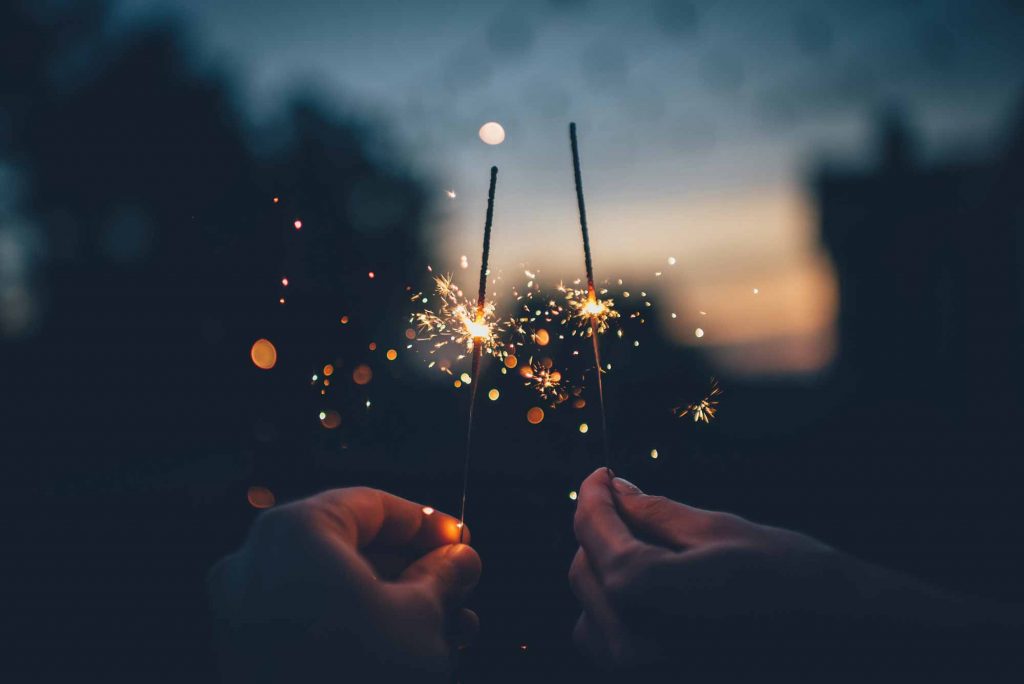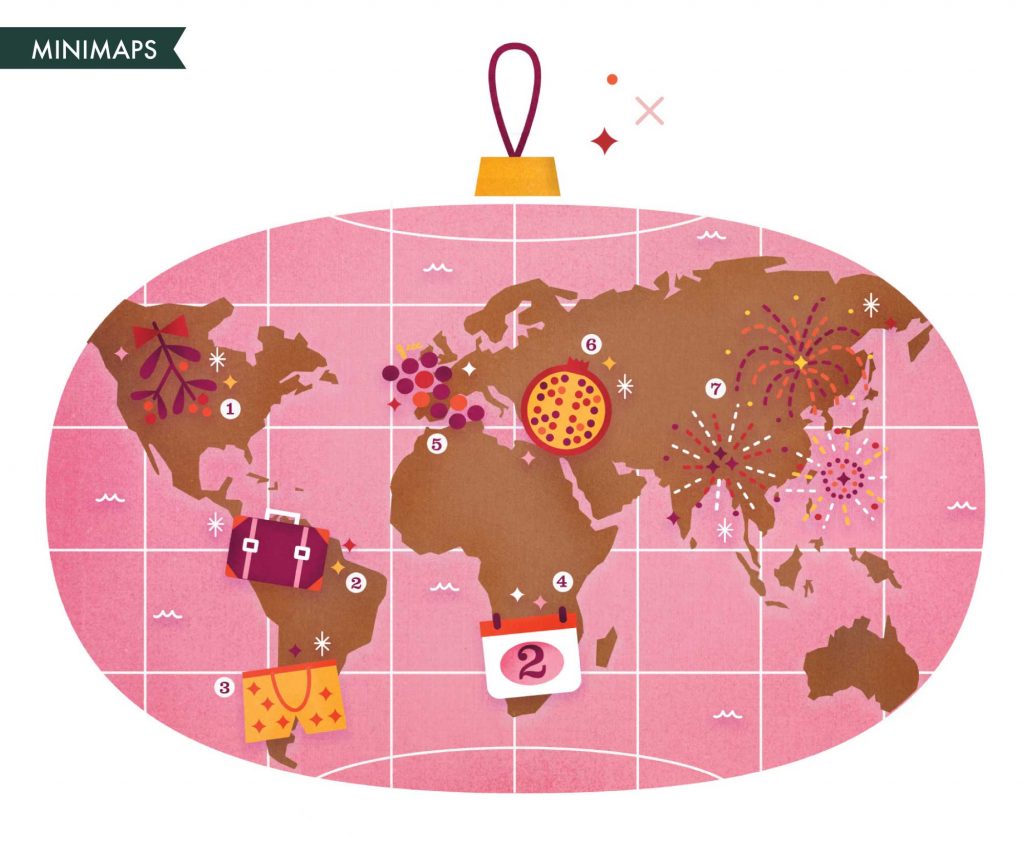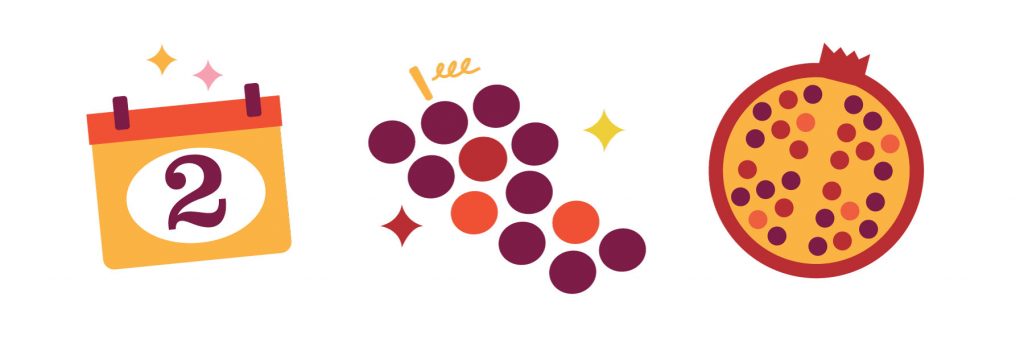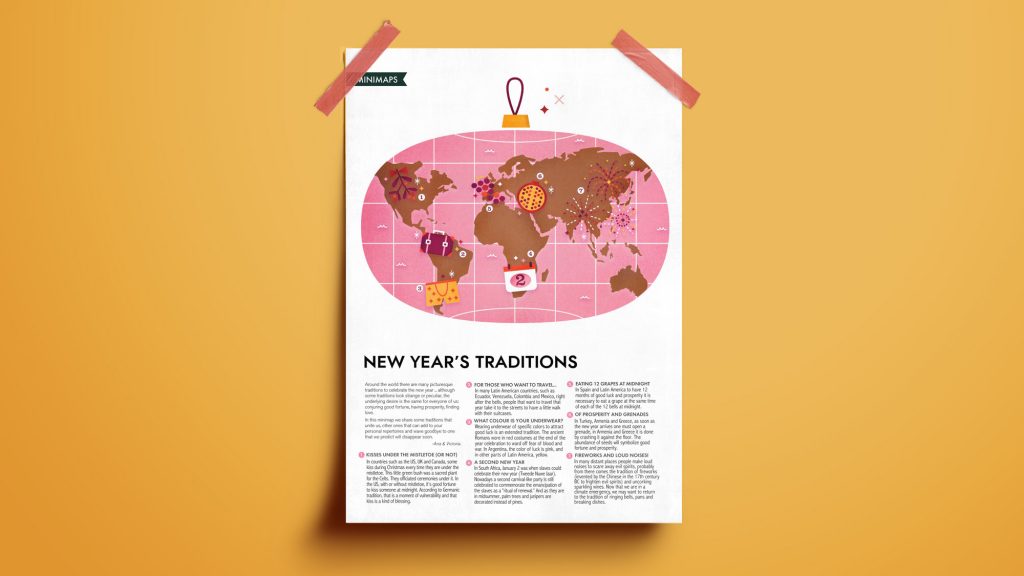
…
Around the world there are many quite picturesque traditions to celebrate the new year … although some traditions look strange or completely peculiar, the underlying desire is the same: conjuring good fortune, having prosperity, finding love.
In this minimap we share some traditions that you can add to your personal repertoires and say goodbye to one that we predict will disappear soon
Edited by Ana Laya & illustrated by Victoria Fernández.
Cover Photo: Ian Schneider via Unsplash.
…

Free to download, ready to print!
…
1. Kisses Under the Mistletoe (or not)
In countries such as the US, UK and Canada, some kiss during Christmas every time they are under the mistletoe. This little green bush was a sacred plant for the Celts. They used to officiate ceremonies under him.
However this plant has been linked to many stories and traditions over hundreds of years, and different people, from various places, see it in different ways.
One of the more common beliefs is that mistletoe is a symbol of fertility and life. This would be an obvious reason of why we kiss underneath it.
Also, in winter, when all the trees are bare and many plants have died away, mistletoe is still green and you can still see it growing around tree branches quite happily.
In the US, with or without mistletoe, it’s good fortune to kiss someone right at midnight (we’ve seen it in a thousand movies, I’m thinking: When Harry Met Sally). According to Germanic tradition, that is a moment of vulnerability and that kiss is a kind of blessing. At present it is said that it strengthens the links and gives good luck.
Finally, it is said that if a single woman puts a bit of mistletoe under her pillow before going to bed on New Year’s Eve this will bring true love and marriage (well, love and marriage no longer necessarily come together, it’s not the 1950’s anymore) in the new year. Some also believe that sleeping with mistletoe under your pillow on New Year’s Eve helps to get rid of bad luck.
.
2. For those who want to travel…
In several countries, especially Latin American, such as Ecuador, Venezuela, Colombia and Mexico, right after the midnight bells people leave their houses with their favourite suitcase to take a small walk around the corner so they get to travel and have fabulous adventures in the year that it just starting.
Some families do it all together, and it is also popular with lovers and newlyweds. Worry not, the suitcases can be empty! Fortunately the tradition doesn’t say anything about packing.
.
3. What colour is your underwear?
Wearing underwear of specific colours to attract good luck (or love, or money) is a tradition all over the world. Perhaps it comes from Italy, where it is said that the ancient Romans wore in red costumes at the end of the year celebration to ward off fear of blood and war.
The more strict tradition asks that the piece of clothing be given away and it has to be discarded at the moment the new year begins (perhaps because of sustainability we omit this part). In Argentina, the color of luck is pink, and in other parts of Latin America, yellow, and it you’re looking for love, well, you know, it’s always red.

4. A second new year
In South Africa, January 2nd was when slaves could celebrate their new year (Tweede Nuwe Jaar) and in fact it was the only day off they had in the year.
Nowadays a second carnival-like party is still celebrated to commemorate the emancipation of the slaves and as a “ritual of renewal.” And as they are in midsummer, palm trees and junipers are decorated instead of pines.
The Cape Town Minstrel Carnival is one of the oldest celebrations Cape Town, and it is a colourful parade that is as rich in history as it is in culture and extravagance. It’s a lively event popular with all locals in Cape Town and is considered a must-see for all visitors.
.
5. Eating grapes at midnight
In Spain originally and then in a good part of Latin America it is traditional to eat a grape with each clock bell strike at midnight of December 31 for a year of good luck and prosperity.
This ritual apparently goes date back from at least 1895 but became established in 1909. In December of that year, some vine growers from Alicante popularised this custom to better sell huge numbers of grapes from an excellent harvest.
You can eat the grapes wherever you are, but there is a big party at Madrid’s main square, La Puerta del Sol, that is enjoyed by hundreds and followed by millions as it is covered by almost every television channel. Also, according to Wikipedia this is where this tradition started.
There is a pretty popular 80’s song by a Spanish pop band named Mecano about this tradition: En la Puerta del Sol como el año que fue, otra vez el champán y las uvas y el alquitrán… de alfombra están.
.
6. Of prosperity and pomegranates
In Turkey, Armenia and Greece, as soon as the new year arrives one must open a pomegranate, in Armenia and Greece it is made crashing it against the floor. The abundance of seeds will symbolise good fortune and prosperity.
Other traditions, such as eating lentils in Italy, passing coins from one hand to another in Mexico, or dressing in suits with polka dots in Filipinas also have to do with prosperity.
While in Finland horseshoes and in Germany and in Austria lead dolls, are melted and then thrown into the water to read the fortune in the abstract forms that the metal makes (called Bleigieben), similar to how coffee grounds are read.
In other countries, such as El Salvador and Colombia, an egg submerged in water (Oomancy) is read instead of a metal figure.

7. Evil spirits, loud noises and fireworks
In ancient cultures, practically all around the world, there was a ritual that implied noise and fire to dispel evil spirits and bring about good fortune and happiness.
Now we have fireworks and sparkling wines being loudly uncorked at midnight.
Fireworks were invented in the 7th century, during the rule of Tang Dynasty in China precisely with the purpose of frightening evil spirits. Later on they were seen at various festivals around China, and eventually, they became popular in other cultures and societies.
Fireworks though propel a cocktail of chemicals into the atmosphere, and release a fine cloud of smoke and particulate matter that affect local air quality, so maybe from we may want to return to the tradition of ringing bells, pans and breaking dishes (a lot of cultures still do that)… or at least carefully look for the lesser toxic alternatives.

Happy new year, friends!
Download and print your minimap here.

To share your photos with other minimappers, please use this hashtag #superminimaps in Twitter and Instagram!
♥
…



